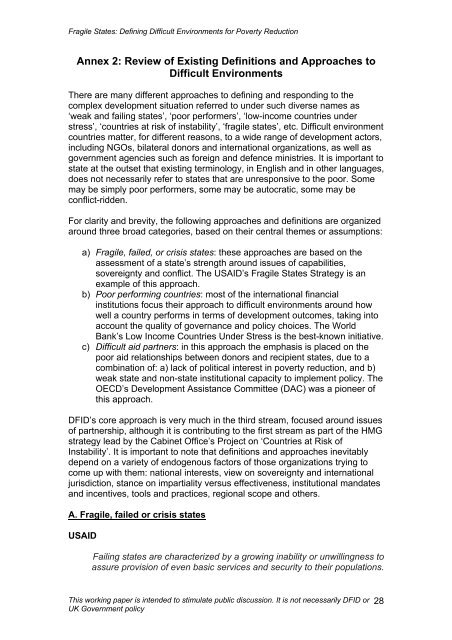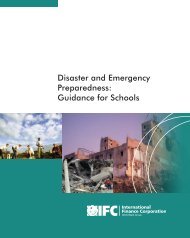Fragile States: Defining Difficult Environments for Poverty ... - INEE
Fragile States: Defining Difficult Environments for Poverty ... - INEE
Fragile States: Defining Difficult Environments for Poverty ... - INEE
You also want an ePaper? Increase the reach of your titles
YUMPU automatically turns print PDFs into web optimized ePapers that Google loves.
<strong>Fragile</strong> <strong>States</strong>: <strong>Defining</strong> <strong>Difficult</strong> <strong>Environments</strong> <strong>for</strong> <strong>Poverty</strong> ReductionAnnex 2: Review of Existing Definitions and Approaches to<strong>Difficult</strong> <strong>Environments</strong>There are many different approaches to defining and responding to thecomplex development situation referred to under such diverse names as‘weak and failing states’, ‘poor per<strong>for</strong>mers’, ‘low-income countries understress’, ‘countries at risk of instability’, ‘fragile states’, etc. <strong>Difficult</strong> environmentcountries matter, <strong>for</strong> different reasons, to a wide range of development actors,including NGOs, bilateral donors and international organizations, as well asgovernment agencies such as <strong>for</strong>eign and defence ministries. It is important tostate at the outset that existing terminology, in English and in other languages,does not necessarily refer to states that are unresponsive to the poor. Somemay be simply poor per<strong>for</strong>mers, some may be autocratic, some may beconflict-ridden.For clarity and brevity, the following approaches and definitions are organizedaround three broad categories, based on their central themes or assumptions:a) <strong>Fragile</strong>, failed, or crisis states: these approaches are based on theassessment of a state’s strength around issues of capabilities,sovereignty and conflict. The USAID’s <strong>Fragile</strong> <strong>States</strong> Strategy is anexample of this approach.b) Poor per<strong>for</strong>ming countries: most of the international financialinstitutions focus their approach to difficult environments around howwell a country per<strong>for</strong>ms in terms of development outcomes, taking intoaccount the quality of governance and policy choices. The WorldBank’s Low Income Countries Under Stress is the best-known initiative.c) <strong>Difficult</strong> aid partners: in this approach the emphasis is placed on thepoor aid relationships between donors and recipient states, due to acombination of: a) lack of political interest in poverty reduction, and b)weak state and non-state institutional capacity to implement policy. TheOECD’s Development Assistance Committee (DAC) was a pioneer ofthis approach.DFID’s core approach is very much in the third stream, focused around issuesof partnership, although it is contributing to the first stream as part of the HMGstrategy lead by the Cabinet Office’s Project on ‘Countries at Risk ofInstability’. It is important to note that definitions and approaches inevitablydepend on a variety of endogenous factors of those organizations trying tocome up with them: national interests, view on sovereignty and internationaljurisdiction, stance on impartiality versus effectiveness, institutional mandatesand incentives, tools and practices, regional scope and others.A. <strong>Fragile</strong>, failed or crisis statesUSAIDFailing states are characterized by a growing inability or unwillingness toassure provision of even basic services and security to their populations.This working paper is intended to stimulate public discussion. It is not necessarily DFID orUK Government policy28
















